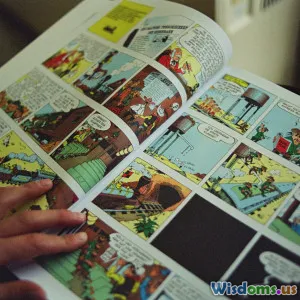
Secrets Costume Departments Use to Make Fight Scenes Believable
15 min read Behind-the-scenes insights into how costume departments ingeniously create authentic, safe, and visually thrilling fight scenes for film and television. (0 Reviews)
Secrets Costume Departments Use to Make Fight Scenes Believable
Fight scenes—whether bone-crunching brawls in superhero sagas or tense duels in period dramas—don't just captivate us with choreography and sound effects. Central to their believability is the meticulous work of costume departments. While stunt performers and actors take the front lines, it’s the costumiers that ensure every punch, tear, and tumble looks— and feels—real to the audience.
Have you ever wondered how costumes stay intact during lengthy, explosive altercations? Or how actors appear comfortable, agile, and ultra-cool—even as they’re thrown across set pieces or braving CGI flames? Dive behind the scenes and discover the remarkable secrets costume departments use to engineer authenticity, safety, and spectacle into every fight scene.
Table of Contents
- Introduction
- Fusion of Function & Drama: The Art of Fight Costuming
- Superficial Strength: Materials That Withstand Mayhem
- Special Effects Built Into Wardrobe
- Strategic Padding and Concealed Protection
- The Magic of Multiples and Fast Repairs
- Wear and Tear: Storytelling Through Damage
- Realism in Period and Fantasy Costumes
- Collaboration: The Unseen Alliance with Stunt, VFX, and Props Departments
- Conclusion: Costume, Character, and Combat
Introduction
Imagine the thunderous applause as a hero walks away from an epic battle, their costume artfully battered yet still intact. That authenticity is no accident. The hidden world of costume design for fight scenes blends creative flair with engineering smarts. These masters of fabric and form ensure that every movement looks authentic—and feels plausible.
The demand for realism in modern cinema and television has skyrocketed, thanks to increasingly sophisticated viewers. According to award-winning costume designer Lindy Hemming (The Dark Knight Trilogy), "Costumes must allow for choreography, stunts, and, above all, the actor’s safety while convincing the audience of the effort and pain of combat."
Let’s unravel some of the most closely-guarded secrets in modern costume departments and explore how they keep audiences on the edge of their seats.
Fusion of Function & Drama: The Art of Fight Costuming
A costume isn’t just attire—it’s functionally engineered for physical performance. Fight scene costuming demands an intersection between narrative storytelling, visual impact, and practical needs:
-
Design for Movement: Garments are built for maximum flexibility. Materials are often intentionally cut on the bias, with hidden gussets or stretch panels added in underarms, crotch, or shoulders. Good example: Marvel’s Black Widow suits use a blend of leather and stretch synthetics so Scarlett Johansson could kick high, flip, and tumble without wardrobe malfunction.
-
Concealed Closures: Visible fasteners (think buttons and zippers) are replaced by highly durable Velcro, snaps, or invisible zippers. This both preserves the visual line and prevents dangerous snagging.
-
Redundant Designs: For fight scenes, designers prepare multiple versions: “Hero” versions for close-ups, “Stunt” versions made tougher for action, and “Backup” for accidents.
In the series The Witcher, costume designer Tim Aslam noted that Geralt’s armor—worn by Henry Cavill—was made in about a dozen versions, each subtly tailored for swordwork, galloping on horseback, or shooting dialogue scenes.
Superficial Strength: Materials That Withstand Mayhem
A suit that looks like steel but bends like bandage—this is the science of clandestine materials.
-
Flexible Faux Armors: Periodical dramas or high fantasy series (think Game of Thrones) need armor that won’t injure the performer. Mithril-like chainmail is often substituted with lightweight, soft plastics painted to glossy realism. Lord of the Rings used PVC maille, with chainmaille pieces handpainted for close-ups.
-
Elastic Leathers and Synthetic Blends: Genuine leather is both expensive and stiff. Costume departments source custom-formulated linens, leathers with built-in stretch, or polyurethane composites for form-fitting looks (as in Daredevil’s daredevil red suit).
-
Reinforced Fabrics: Modern "bulletproof" fabric panels, aramid fibers (like Kevlar), are inserted at high-impact points to resist tearing during scuffles. These are lightweight enough not to restrict movement but strong enough to protect the garment—and performer.
In the blockbuster Mad Max: Fury Road, costume designer Jenny Beavan reportedly used repurposed motorcycle gear, reinforced with Kevlar patches, to ensure both authenticity and safety for Tom Hardy’s high-octane chases—proving costumes can save lives on and off screen!
Special Effects Built Into Wardrobe
Costume departments must anticipate every abrasion, splash, or burn an on-screen fight delivers—even if aided by VFX later. But often, special-effects are woven directly into costume design:
-
Blood Packs and Quick-Rigged Damage: Detachable panels fitted with blood squibs (small explosive bags of fake blood) allow actors to simulate wounds in real time. The iconic hallway fight scene in the original Oldboy (2003) used dozens of such rigs to synchronize costume blood with the actor’s performance.
-
Breakaway Garments: Sometimes, clothing must dramatically rip or shatter—think shirts torn off in wrestling matches. Departments pre-score seams or use "breakaway" textiles that tear along set lines without harming the actor. In John Wick, costume teams developed shirts with specialized bias stitching so Keanu Reeves’ character could shrug off attackers without a hitch.
-
Fire, Smoke, or Water-Resistant Treatments: For scenes involving fire or water, costumes are treated with retardants or made with fast-drying synthetics. Game of Thrones famously designed fireproof costumes for "Mother of Dragons" sequences—using 21st-century intumescent coatings!
Strategic Padding and Concealed Protection
Actors and stunt performers often appear to tumble, fall, or punch with abandon. The secret? Much of the pain and danger is softened by costuming wizardry:
-
Hidden Padding: Elbows, knees, shoulders, and even ribs are selectively padded with impact foam or gel. Designs are carefully contoured not to add bulk, ensuring the camera sees only the character, not the safety gear.
-
Double Lining for Stunt-Heavy Garb: Interior linings absorb sweat and shock, while allowing quick swaps if things get messy. In George Miller’s Mad Max: Fury Road, every jacket worn in stunts was double- or triple-lined with soft, wicking fabrics for comfort, breathability, and cushioning.
-
Masking Braces and Safety Gear: For over-the-top action (think Mission: Impossible or Marvel’s Avengers), costumiers work in concert with stunt teams—modifying armors or jackets to fit braces, harnesses, or even wire rigs without breaking the visual illusion.
Veteran costume supervisor Tina Schlink, who worked on The Bourne Ultimatum, remarked, "Every piece was a puzzle—each must cover padding but never restrict grip, slide, or rotation."
The Magic of Multiples and Fast Repairs
Even the toughest costume can’t last through dozens of takes. The unsung workhorses of fight scene costuming are mass redundancy and lightning-fast repair.
-
Multiple Sets: Costume teams prepare up to 50 repeat outfits for principal action roles in intensive fight films. Christopher Nolan’s The Dark Knight, for example, had at least 30 Batsuits in varying states of distress ready for each stage of Batman’s trials.
-
Emergency Repair Stations: On chaotic sets, the "wardrobe tent" is stocked with glues, sewing machines, dyes, and stationary heat guns. During the shoot of The Matrix, a single torn coat seam could be fixed and replaced within minutes between takes.
-
Continuity Bookkeeping: It’s not just about making; it’s maintaining. On-set costumiers maintain continuity “bibles” to ensure each rip and stain matches the narrative progression of the fight—to avoid the notorious "suddenly repaired" shirt error!
Wear and Tear: Storytelling Through Damage
Damage is more than spectacle. It’s storytelling—showing the toll of combat on both body and attire. Costume designers simulate wear with specialist techniques:
-
Aging and Distressing Techniques: Before filming, garments undergo “breaking down” processes, including sanding, waxing, scraping, even mild acid-etching to mimic genuine battle wear. In Gladiator, Russell Crowe’s armor was repeatedly darkened and re-scuffed to chart Maximus’s journey from general to slave to rebel.
-
Layered Breakage: Some costumes are pre-designed to show multiple layers as the fight intensifies: a shirt tears to reveal a bloodstained undershirt, conveying more intense struggle.
-
Hand-Painted Blood and Sweat: Prosthetic wounds might be added, but painted blood and grime on costumes sustains the illusion between takes or after practical stunts have finished.
According to Mary E. Vogt, designer on Black Panther, “Our costumes almost became indexes of the action—they needed to record impact after impact, across every level of the story.”
Realism in Period and Fantasy Costumes
Fight scenes in period or fantasy settings pose unique challenges. Imagine maintaining 17th-century elegance while fighting pirates or filming with a dragon overhead.
-
Historical Accuracy Meets Safety: Swordfights, for example, require period-correct garb that doesn’t impede movement. Costume expert Jenny Shircore (Elizabeth) often has garments reinforced with hidden elastic and snap-away seams, invisible to camera, but crucial in the heat of a duel.
-
Fantasy Flexibility: Superhero or sci-fi costumes require mobility plus signature looks. Designer Ruth E. Carter (Black Panther) integrated tribal influences with lightweight 3D-printed armor, merging real-world culture with stunt-functionality.
-
Subtle Modernizations: In Netflix’s The Witcher, period-style garb for fast-paced battles swaps stiff, heavy linen for soft jersey and stretch knits, delivering the silhouette without the immobility.
Authenticity and anachronism often collide—so designers subtly "cheat" the fabric for survival and safety.
Collaboration: The Unseen Alliance with Stunt, VFX, and Props Departments
A costume doesn’t work in isolation. The finest fight costumes result from intensive collaboration among several departments:
-
Stunt Consultation: Designers work intimately with fight choreographers to understand actor movement and safety needs. During the making of Atomic Blonde, Charlize Theron trained in her actual stunt outfits so adjustments could be made for the brutal, single-take fight centerpiece.
-
Prop Integration: Belts, weapons, and holsters must stay put—even in a tumble. Costumiers embed hooks and locking snaps directly into seams, ensuring swords and pistols won’t fly off untimely.
-
CGI and Visual Effects Planning: Costumes need to anticipate post-production, using “neutral” colors or materials for later adjustment, or integrating motion-capture marker points. Tom Holland’s enhanced Spider-Man suit, for instance, featured markers inside the costume for VFX edits.
-
Sweat, Blood, and Gore Teams: Even the FX team prepping the fake blood collaborates with the wardrobe, ensuring it doesn’t stain or stiffen fabrics in a way that would ruin dozens of takes.
Conclusion: Costume, Character, and Combat
Next time you're awed by a whirlwind fight on the big screen—look closely. The battered tunic, split armor seams, and perfectly-placed scarlet stains are not accidental. They’re the product of months of pre-visualization, collaboration, and relentless craftsmanship.
Costume departments are the unsung guardians of plausibility; they bridge the world between cinematic magic and physical law. As film and television action becomes ever more audacious, the genius of costume design will remain essential—not just as fashion, but as pivotal, technical storytelling.
Perhaps appreciating the detail and daring behind the clothing will help you see fight scenes anew—not as choreographed spectacle alone, but as a triumph of collaborative creativity, where fabric and fist fit together in seamless harmony.
Rate the Post
User Reviews
Popular Posts


















